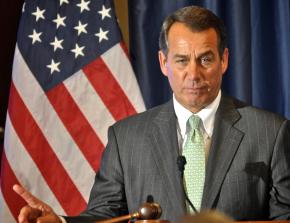A federal government shutdown?
looks at what's at stake in the latest Washington budget battle.
THE FEDERAL government could shut down at midnight on Friday if Republican congressional leaders and the Obama White House don't agree on legislation to fund its operations.
Both parties claim they want to avoid a shutdown, which would halt all "nonessential" government services and leave as many as 800,000 workers on indefinite furlough until funding legislation is passed, according to the White House.
But the part of this story that gets lost in the mainstream media's frantic coverage of the behind-closed-doors negotiations is that the "debate" isn't whether or not to cut, but how deep to go.
This current budget battle isn't even over future spending--it's about government operations through the end of the current fiscal year on September 30. The last Congress never passed a final budget, so since last fall, the government has been kept going with stopgap spending measures--known as "continuing resolutions"--that run a few months or even a few weeks.
When the new Republican majority took over in the House this year, GOP leaders declared they wanted to stop "runaway spending" right away and demanded even deeper cuts in the final budget for this fiscal year. The new House leadership at first seemed ready to go with a figure of $30 billion, but the Tea Party fanatics insisted on more than $60 billion in cuts--and House Speaker John Boehner went along with their demand.

A shutdown loomed at the beginning of March, but the White House and Republican leaders came up with another stopgap measure, and then another, though at a cost of billions in cuts toward what the Republicans want. Now the clock is ticking again, and Democrats are rejecting any more short-term spending bills.
To listen to the grandstanding, you might think that the Obama administration was fending off the budget-cutting wolves at the door with its bare hands. But according to news reports, Obama is drawing the line with the Republicans by offering to accept $33 billion in reductions from current spending levels--$23 billion on top of $10 billion that Congress already passed in continuing resolutions.
In other words, Obama's hard-and-fast position is the original level of cuts the Republican leadership wanted in January. According to media reports, Boehner and the Republicans now want $40 billion.
There are other disputes--over where the reductions should come and whether Republicans will be allowed to tack on conservative policy provisions. But the bigger point is that the Democrats have given up so much ground in this budget battle that they're now standing where the Republicans were three months ago.
To be sure, the Republican budget proposal is nothing less than an all-out assault on workers, the elderly and the poor, laying out deep cuts in the social services and health programs that millions rely on.
Among the targets of House Republicans last February when they passed a bill for $61 billion in cuts was funding for health care, Head Start and Pell Grants--their legislation also blocked enforcement of new financial regulations, cut off federal funding for Planned Parenthood and weakened the Environmental Protection Agency's (EPA) enforcement capabilities.
The Democrats' counter-proposal reportedly looks to push some of the cuts onto the Pentagon in order to protect funding for priorities such as the EPA. But no one should be under any illusion that the Obama White House isn't ready to wield the budget ax against the same agencies and programs that Republicans have targeted. After all, the administration's budget outline for the next fiscal year 2012, unveiled in February, proposes to take away $100 billion from the Pell Grant program over 10 years.
THE DEMOCRATS' refusal to fight in any meaningful way--and, on the contrary, to give up ground at every stage--has meant that the Republicans have been allowed to set the agenda in Washington.
But this is in large part because the two parties' agendas overlap considerably. Both are intent on passing the ravages of the economic crisis onto workers and the poor, while protecting the profits and power of Corporate America. Their budget wrangles are over the details, not the overall drive for austerity.
All this is a sharp contrast to the real concerns that the majority of people face every day. According to a CBS News poll last month that asked, "What do you think is the most important problem facing this country today?" only 7 percent of people said the budget deficit/national debt; 51 percent said the economy and jobs.
The battle over a federal shutdown is the latest example of how out of touch Washington leaders are--and how far they're willing to go to impose austerity, and call it fiscal responsibility.
If political leaders wanted to save enough money to preserve the social programs so many millions depend on, they could take a crack at the real "nonessential" services of the U.S. government: giant loopholes that allow the world's richest corporations to get away with paying nothing at all in taxes; the extension of the Bush tax breaks for the super-rich; and funding for U.S. wars in Afghanistan, Iraq and Libya.
But none of this is ever "on the table." The debate is how much to carve out of social programs and government agencies that have already been cut to the bone.
The last federal government shutdown was in 1995, when the "Republican revolutionaries" led by Newt Gingrich tried to force through draconian spending cuts by claiming they had a mandate from the 1994 election. But the Republicans rapidly became despised for their willingness to watch vital services like Social Security, Medicare and the Veterans Administration be disrupted in the service of their conservative crusade.
But other lesson of the Republican Revolution is that while Gingrich and the GOP grew more and more hated, the Democratic White House of Bill Clinton ended up following through on large sections of the Republicans' platform. Thus, it was Clinton and the Democrats, not the Republicans, who succeeded in pushing through welfare "reform"--while pretending that they were defending poor families against an even worse Republican onslaught.
These lessons will be important to remember, because shutdown or no shutdown, the battles over the budget are far from over. That was clear from the doomsday proposal unveiled last week by Rep. Paul Ryan, the Republican head of the House Budget Committee.
Ryan's proposal, which he calls the "Path to Prosperity"--translation for millions of workers: "Road to Ruin"--would cut $6 trillion in federal spending over six years, including devastating cuts in the government's Medicaid health care program for the poor and privatization of the Medicare program for the elderly.
The message couldn't be clearer: The Republicans are seeking long-term solutions to what they see as the "problem" of a social safety net existing in the U.S. But the Democrats are proving at every step that they'll let the right wing's most extreme proposals become the mainstream of the political debate.


